Alexander Hanbo Li
A1: Asynchronous Test-Time Scaling via Conformal Prediction
Sep 18, 2025Abstract:Large language models (LLMs) benefit from test-time scaling, but existing methods face significant challenges, including severe synchronization overhead, memory bottlenecks, and latency, especially during speculative decoding with long reasoning chains. We introduce A1 (Asynchronous Test-Time Scaling), a statistically guaranteed adaptive inference framework that addresses these challenges. A1 refines arithmetic intensity to identify synchronization as the dominant bottleneck, proposes an online calibration strategy to enable asynchronous inference, and designs a three-stage rejection sampling pipeline that supports both sequential and parallel scaling. Through experiments on the MATH, AMC23, AIME24, and AIME25 datasets, across various draft-target model families, we demonstrate that A1 achieves a remarkable 56.7x speedup in test-time scaling and a 4.14x improvement in throughput, all while maintaining accurate rejection-rate control, reducing latency and memory overhead, and no accuracy loss compared to using target model scaling alone. These results position A1 as an efficient and principled solution for scalable LLM inference. We have released the code at https://github.com/menik1126/asynchronous-test-time-scaling.
DSMentor: Enhancing Data Science Agents with Curriculum Learning and Online Knowledge Accumulation
May 20, 2025Abstract:Large language model (LLM) agents have shown promising performance in generating code for solving complex data science problems. Recent studies primarily focus on enhancing in-context learning through improved search, sampling, and planning techniques, while overlooking the importance of the order in which problems are tackled during inference. In this work, we develop a novel inference-time optimization framework, referred to as DSMentor, which leverages curriculum learning -- a strategy that introduces simpler task first and progressively moves to more complex ones as the learner improves -- to enhance LLM agent performance in challenging data science tasks. Our mentor-guided framework organizes data science tasks in order of increasing difficulty and incorporates a growing long-term memory to retain prior experiences, guiding the agent's learning progression and enabling more effective utilization of accumulated knowledge. We evaluate DSMentor through extensive experiments on DSEval and QRData benchmarks. Experiments show that DSMentor using Claude-3.5-Sonnet improves the pass rate by up to 5.2% on DSEval and QRData compared to baseline agents. Furthermore, DSMentor demonstrates stronger causal reasoning ability, improving the pass rate by 8.8% on the causality problems compared to GPT-4 using Program-of-Thoughts prompts. Our work underscores the importance of developing effective strategies for accumulating and utilizing knowledge during inference, mirroring the human learning process and opening new avenues for improving LLM performance through curriculum-based inference optimization.
Towards Better Understanding Table Instruction Tuning: Decoupling the Effects from Data versus Models
Jan 24, 2025



Abstract:Recent advances in natural language processing have leveraged instruction tuning to enhance Large Language Models (LLMs) for table-related tasks. However, previous works train different base models with different training data, lacking an apples-to-apples comparison across the result table LLMs. To address this, we fine-tune base models from the Mistral, OLMo, and Phi families on existing public training datasets. Our replication achieves performance on par with or surpassing existing table LLMs, establishing new state-of-the-art performance on Hitab, a table question-answering dataset. More importantly, through systematic out-of-domain evaluation, we decouple the contributions of training data and the base model, providing insight into their individual impacts. In addition, we assess the effects of table-specific instruction tuning on general-purpose benchmarks, revealing trade-offs between specialization and generalization.
Few-Shot Data-to-Text Generation via Unified Representation and Multi-Source Learning
Aug 10, 2023Abstract:We present a novel approach for structured data-to-text generation that addresses the limitations of existing methods that primarily focus on specific types of structured data. Our proposed method aims to improve performance in multi-task training, zero-shot and few-shot scenarios by providing a unified representation that can handle various forms of structured data such as tables, knowledge graph triples, and meaning representations. We demonstrate that our proposed approach can effectively adapt to new structured forms, and can improve performance in comparison to current methods. For example, our method resulted in a 66% improvement in zero-shot BLEU scores when transferring models trained on table inputs to a knowledge graph dataset. Our proposed method is an important step towards a more general data-to-text generation framework.
Generate then Select: Open-ended Visual Question Answering Guided by World Knowledge
May 30, 2023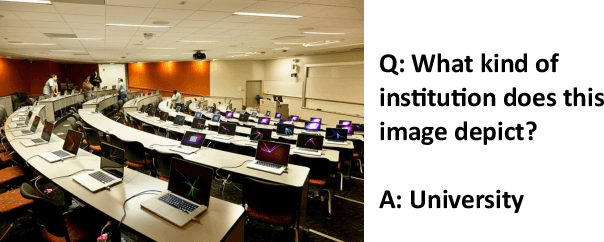


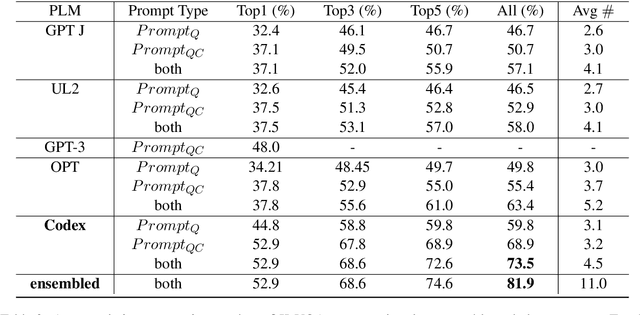
Abstract:The open-ended Visual Question Answering (VQA) task requires AI models to jointly reason over visual and natural language inputs using world knowledge. Recently, pre-trained Language Models (PLM) such as GPT-3 have been applied to the task and shown to be powerful world knowledge sources. However, these methods suffer from low knowledge coverage caused by PLM bias -- the tendency to generate certain tokens over other tokens regardless of prompt changes, and high dependency on the PLM quality -- only models using GPT-3 can achieve the best result. To address the aforementioned challenges, we propose RASO: a new VQA pipeline that deploys a generate-then-select strategy guided by world knowledge for the first time. Rather than following the de facto standard to train a multi-modal model that directly generates the VQA answer, RASO first adopts PLM to generate all the possible answers, and then trains a lightweight answer selection model for the correct answer. As proved in our analysis, RASO expands the knowledge coverage from in-domain training data by a large margin. We provide extensive experimentation and show the effectiveness of our pipeline by advancing the state-of-the-art by 4.1% on OK-VQA, without additional computation cost. Code and models are released at http://cogcomp.org/page/publication_view/1010
Benchmarking Diverse-Modal Entity Linking with Generative Models
May 27, 2023Abstract:Entities can be expressed in diverse formats, such as texts, images, or column names and cell values in tables. While existing entity linking (EL) models work well on per modality configuration, such as text-only EL, visual grounding, or schema linking, it is more challenging to design a unified model for diverse modality configurations. To bring various modality configurations together, we constructed a benchmark for diverse-modal EL (DMEL) from existing EL datasets, covering all three modalities including text, image, and table. To approach the DMEL task, we proposed a generative diverse-modal model (GDMM) following a multimodal-encoder-decoder paradigm. Pre-training \Model with rich corpora builds a solid foundation for DMEL without storing the entire KB for inference. Fine-tuning GDMM builds a stronger DMEL baseline, outperforming state-of-the-art task-specific EL models by 8.51 F1 score on average. Additionally, extensive error analyses are conducted to highlight the challenges of DMEL, facilitating future research on this task.
Dr.Spider: A Diagnostic Evaluation Benchmark towards Text-to-SQL Robustness
Jan 21, 2023



Abstract:Neural text-to-SQL models have achieved remarkable performance in translating natural language questions into SQL queries. However, recent studies reveal that text-to-SQL models are vulnerable to task-specific perturbations. Previous curated robustness test sets usually focus on individual phenomena. In this paper, we propose a comprehensive robustness benchmark based on Spider, a cross-domain text-to-SQL benchmark, to diagnose the model robustness. We design 17 perturbations on databases, natural language questions, and SQL queries to measure the robustness from different angles. In order to collect more diversified natural question perturbations, we utilize large pretrained language models (PLMs) to simulate human behaviors in creating natural questions. We conduct a diagnostic study of the state-of-the-art models on the robustness set. Experimental results reveal that even the most robust model suffers from a 14.0% performance drop overall and a 50.7% performance drop on the most challenging perturbation. We also present a breakdown analysis regarding text-to-SQL model designs and provide insights for improving model robustness.
DecAF: Joint Decoding of Answers and Logical Forms for Question Answering over Knowledge Bases
Sep 30, 2022



Abstract:Question answering over knowledge bases (KBs) aims to answer natural language questions with factual information such as entities and relations in KBs. Previous methods either generate logical forms that can be executed over KBs to obtain final answers or predict answers directly. Empirical results show that the former often produces more accurate answers, but it suffers from non-execution issues due to potential syntactic and semantic errors in the generated logical forms. In this work, we propose a novel framework DecAF that jointly generates both logical forms and direct answers, and then combines the merits of them to get the final answers. Moreover, different from most of the previous methods, DecAF is based on simple free-text retrieval without relying on any entity linking tools -- this simplification eases its adaptation to different datasets. DecAF achieves new state-of-the-art accuracy on WebQSP, FreebaseQA, and GrailQA benchmarks, while getting competitive results on the ComplexWebQuestions benchmark.
Improving Text-to-SQL Semantic Parsing with Fine-grained Query Understanding
Sep 28, 2022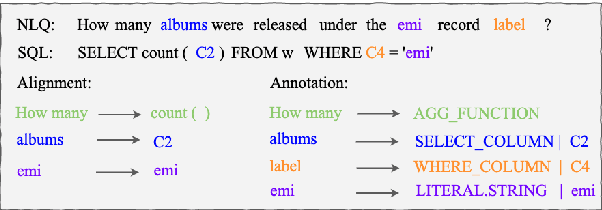
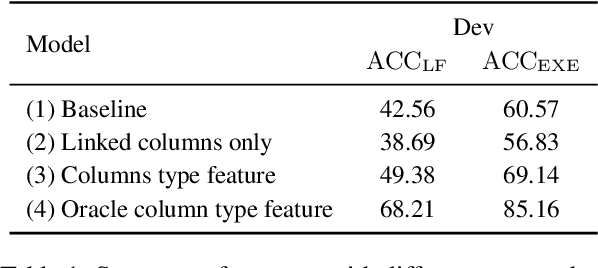
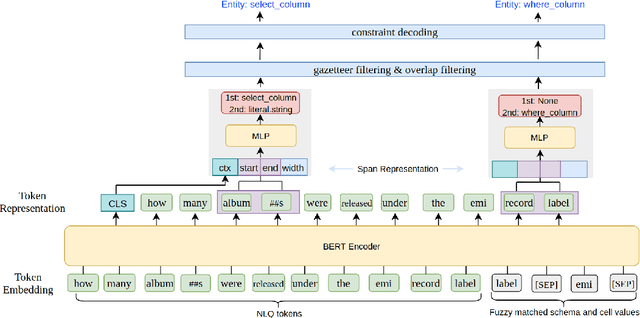
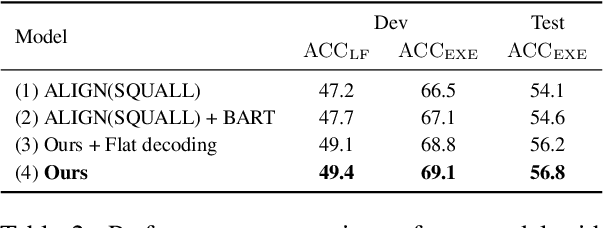
Abstract:Most recent research on Text-to-SQL semantic parsing relies on either parser itself or simple heuristic based approach to understand natural language query (NLQ). When synthesizing a SQL query, there is no explicit semantic information of NLQ available to the parser which leads to undesirable generalization performance. In addition, without lexical-level fine-grained query understanding, linking between query and database can only rely on fuzzy string match which leads to suboptimal performance in real applications. In view of this, in this paper we present a general-purpose, modular neural semantic parsing framework that is based on token-level fine-grained query understanding. Our framework consists of three modules: named entity recognizer (NER), neural entity linker (NEL) and neural semantic parser (NSP). By jointly modeling query and database, NER model analyzes user intents and identifies entities in the query. NEL model links typed entities to schema and cell values in database. Parser model leverages available semantic information and linking results and synthesizes tree-structured SQL queries based on dynamically generated grammar. Experiments on SQUALL, a newly released semantic parsing dataset, show that we can achieve 56.8% execution accuracy on WikiTableQuestions (WTQ) test set, which outperforms the state-of-the-art model by 2.7%.
Learning to Selectively Learn for Weakly-supervised Paraphrase Generation
Sep 25, 2021


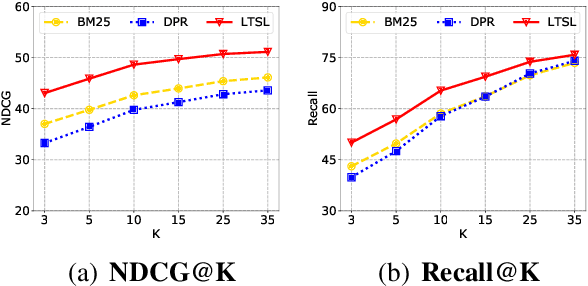
Abstract:Paraphrase generation is a longstanding NLP task that has diverse applications for downstream NLP tasks. However, the effectiveness of existing efforts predominantly relies on large amounts of golden labeled data. Though unsupervised endeavors have been proposed to address this issue, they may fail to generate meaningful paraphrases due to the lack of supervision signals. In this work, we go beyond the existing paradigms and propose a novel approach to generate high-quality paraphrases with weak supervision data. Specifically, we tackle the weakly-supervised paraphrase generation problem by: (1) obtaining abundant weakly-labeled parallel sentences via retrieval-based pseudo paraphrase expansion; and (2) developing a meta-learning framework to progressively select valuable samples for fine-tuning a pre-trained language model, i.e., BART, on the sentential paraphrasing task. We demonstrate that our approach achieves significant improvements over existing unsupervised approaches, and is even comparable in performance with supervised state-of-the-arts.
 Add to Chrome
Add to Chrome Add to Firefox
Add to Firefox Add to Edge
Add to Edge